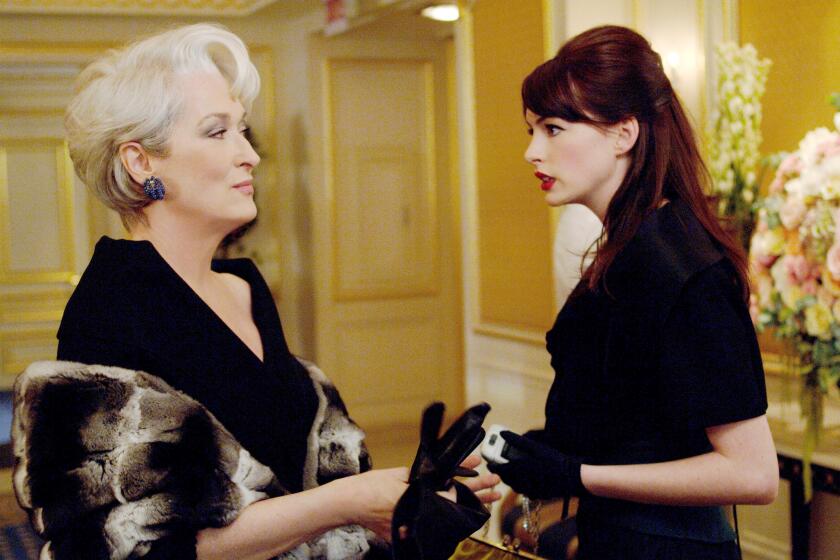Girding for the Fray
- Share via
How wide-open is the race for nominations in this year’s Oscar competition? Consider:
* It’s a year when not one but two foreign-language films have a shot at best picture nominations.
* It’s a year when not one but two independently made costume dramas set in Elizabethan England are among the strongest candidates in the same category.
* It’s a year when two actresses might get nominated for playing a woman dead for almost 400 years.
* It’s a year, in other words, where anything can happen.
Make that almost anything. For if Hollywood savants unite about any point, it’s that Steven Spielberg’s much-lauded World War II drama “Saving Private Ryan” is a lock for a nomination and looks to be the winner of the final contest as well. Though it’s not as much of a gimme, the other studio picture with the best chance is the Peter Weir-directed “The Truman Show,” which featured Jim Carrey as the unknowing star of the most popular TV show on Earth. (Also possible, but distant, is Robert Redford’s “The Horse Whisperer” and Terrence Malick’s equally solemn “The Thin Red Line.”)
When it comes to those Elizabethan pictures, Miramax’s “Shakespeare in Love,” the kind of feel-good, commercial yet intelligent feature the industry looks fondly on, seems irresistible for a nomination. Less sure but still possible if voters feel in a monarchal mood is Gramercy’s pumped-up historical drama “Elizabeth.”
Of the foreign-language films, Roberto Benigni’s Italian concentration camp fable, “Life Is Beautiful,” has all the ingredients to cause the voting academy to swoon and make it the first foreign-language effort to get a best picture nomination since “Il Postino” in 1995.
Also to the academy’s liking would probably be Walter Salles’ Brazilian “Central Station,” if enough voters can be convinced to give the film a chance. Critical nods to star Fernanda Montenegro may help generate enough interest to garner a nomination, but it is a longer shot than the Benigni film.
In the best director category, this fussy academy branch usually goes with the people it knows best. Spielberg is a sure nomination here, “Truman’s” Weir looks to be so as well, and John Madden, whose “Mrs. Brown” was liked by the academy last year, also could manage one for “Shakespeare.”
Though Benigni can’t be completely discounted, it’s likely that the last two nominations will go to directors whose films are probably not going to be best picture selections. John Boorman, well-known here for a lifetime of work, is almost a sure bet for “The General,” with either Malick for “The Thin Red Line” or even Jonathan Demme for “Beloved” possible for the final slot.
In the best actor category, critical choice Ian McKellen is pretty much assured a nomination for his role as “Frankenstein” director James Whale in “Gods and Monsters,” as is Tom Hanks, everybody’s favorite guy, for “Saving Private Ryan,” and Carrey playing against type (very much an academy plus) in “The Truman Show.”
After this, the waters get considerably murkier, with respected industry veteran Nick Nolte’s stark work in Paul Schrader’s “Affliction” landing him at the top of the second tier of choices. Bunched together and striving for the final spot will be Benigni, Sean Penn (for “Hurlyburly” but helped by his work in “The Thin Red Line”), Michael Caine for “Little Voice,” and possibly the magnetic Edward Norton for the understandably little-seen “American History X.”
In the best actress race, academy voters have more options than usual. Cate Blanchett, the British star of “Elizabeth,” is much more likely in her category than the film is overall. Also tough to resist will be “Hilary and Jackie’s” Emily Watson (who was nominated for “Breaking the Waves”), and, of course, Meryl Streep, probably for “One True Thing” rather than “Dancing at Lughnasa.”
Four actresses probably will be vying for the last two slots, including perennial academy favorite Susan Sarandon for “Stepmom” and, if feeling for the film continues strong, Gwyneth Paltrow for “Shakespeare in Love.” Veteran Brazilian actress Montenegro has been mentioned enough to be a contender for “Central Station,” and Jane Horrocks in “Little Voice” is also part of the mix.
Though Cameron Diaz’s engaging work in “There’s Something About Mary” was perhaps the key factor in making that film a considerable success, the fact that the academy has traditionally avoided giving nominations to light comedy work puts her in the longshot category.
In the supporting categories, it’s the men who have the most competition to wade through. The one can’t-miss nominee is, once again, Billy Bob Thornton in “A Simple Plan,” with a whole raft of other guys close at his heels. The likeliest of these include Robert Duvall for “A Civil Action,” Donald Sutherland for “Without Limits,” James Coburn’s change of pace in “Affliction,” Ed Harris for “The Truman Show, “ critical favorite Bill Murray for “Rushmore” and maybe even Geoffrey Rush’s comedic turn in “Shakespeare in Love.”
While both “Saving Private Ryan” and “The Thin Red Line” feature good work by sizable male casts, it’s unlikely that voters will be able to choose just one out of these ensembles. If they do, “Ryan’s” best bet is Jeremy Davies and “Red Line’s” would be, once again, Nolte, who might possibly get two nominations out of the year’s work.
In the best supporting actress category, the two-fer question is whether Judi Dench in “Shakespeare in Love” will be the second actress tapped for playing Elizabeth I in a calendar year. (It’s likely she will.) Other relatively sure bets include Kathy Bates from the otherwise-forgotten “Primary Colors” and the well-respected Joan Allen for “Pleasantville.”
The remaining slots are, once again, wide-open. It could be Kimberly Elise or Beah Richards if the academy feels anything for “Beloved,” or Julia Roberts if “Stepmom” blinds voters with tears. And support for McKellen could spill over onto “Gods and Monsters” co-star Lynn Redgrave, who plays Whale’s put-upon housekeeper.
The two screenplay categories vary from year to year as to which has the strongest group of contenders, and this time the originals are the most compelling. Fairly sure nominees include Andrew Niccol for “The Truman Show,” Marc Norman and Tom Stoppard for “Shakespeare in Love,” and, most likely, Robert Rodat for “Saving Private Ryan.” The independent world has a very strong contender in Todd Solondz’s “Happiness,” and the “Bulworth” team of Warren Beatty and Jeremy Pikser is also a threat. Finally, attention must be paid to scripts by two of the branch’s most respected names: Robert Towne for “Without Limits” and Richard LaGravenese for “Living Out Loud.”
The adapted category, on the other hand, has few, if any, certainties. “Affliction” has gotten a lot of notice, as has “Hilary and Jackie.” Also worth mentioning are “A Simple Plan,” “Primary Colors,” “A Civil Action” and “Gods and Monsters.” The best adapted screenplay of the year may well be Scott Frank’s work on Elmore Leonard’s “Out of Sight” (the film that was the big winner at the National Society of Film Critics voting), but whether this picture lasted long enough to get on the academy’s radar is one of this year’s many open questions.
More to Read
Only good movies
Get the Indie Focus newsletter, Mark Olsen's weekly guide to the world of cinema.
You may occasionally receive promotional content from the Los Angeles Times.











